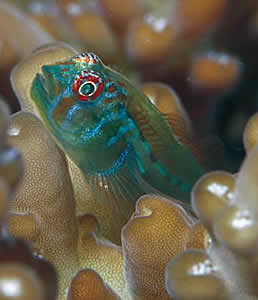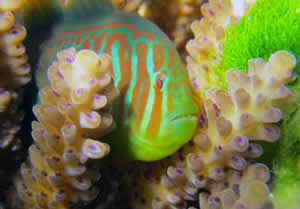
A juvenile Gobidon fish is shown on an Acropora coral, which they protect from encroaching seaweed. Credit: Georgia Tech Photo: Joao Paulo Krajewski

The mutualistic fish Gobidon histrio is shown on the coral Acropora nausuta. Georgia Tech Photo: Danielle Dixson
Corals under attack by toxic seaweed do what anyone might do when threatened â€" they call for help. A study reported this week in the journal Science shows that threatened corals send signals to fish "bodyguards" that quickly respond to trim back the noxious alga â€" which can kill the coral if not promptly removed.
Scientists at the Georgia Institute of Technology have found evidence that these "mutualistic" fish respond to chemical signals from the coral like a 911 emergency call â€" in a matter of minutes. The inch-long fish â€" known as gobies â€" spend their entire lives in the crevices of specific corals, receiving protection from their own predators while removing threats to the corals.
This symbiotic relationship between the fish and the coral on which they live is the first known example of one species chemically signaling a consumer species to remove competitors. It is similar to the symbiotic relationship between Acacia trees and mutualist ants in which the ants receive food and shelter while protecting the trees from both competitors and consumers.
"This species of coral is recruiting inch-long bodyguards," said Mark Hay, a professor in the School of Biology at Georgia Tech. "There is a careful and nuanced dance of the odors that makes all this happen. The fish have evolved to cue on the odor released into the water by the coral, and they very quickly take care of the problem."
The research, supported the National Science Foundation, the National Institutes of Health and the Teasley Endowment at Georgia Tech, was reported November 8 in the journal Science. The research was done as part of a long-term study of chemical signaling on Fiji Island coral reefs aimed at understanding these threatened ecosystems and discovering chemicals that may be useful as pharmaceuticals.
Because they control the growth of seaweeds that damage coral, the importance of large herbivorous fish to maintaining the health of coral reefs has been known for some time. But Georgia Tech postdoctoral fellow Danielle Dixson suspected that the role of the gobies might be more complicated. To study that relationship, she and Hay set up a series of experiments to observe how the fish would respond when the coral that shelters them was threatened.
They studied Acropora nasuta, a species in a genus of coral important to reef ecosystems because it grows rapidly and provides much of the structure for reefs. To threaten the coral, the researchers moved filaments of Chlorodesmis fastigiata, a species of seaweed that is particularly chemically toxic to corals, into contact with the coral. Within a few minutes of the seaweed contacting the coral, two species of gobies â€" Gobidon histrio and Paragobidon enchinocephalus â€" moved toward the site of contact and began neatly trimming away the offending seaweed.
"These little fish would come out and mow the seaweed off so it didn't touch the coral," said Hay, who holds the Harry and Linda Teasley Chair in Environmental Biology at Georgia Tech. "This takes place very rapidly, which means it must be very important to both the coral and the fish. The coral releases a chemical and the fish respond right away."
In corals occupied by the gobies, the amount of offending seaweed declined 30 percent over a three-day period, and the amount of damage to the coral declined by 70 to 80 percent. Control corals that had no gobies living with them had no change in the amount of toxic seaweed and were badly damaged by the seaweed.
To determine what was attracting the fish, Dixson and Hay collected samples of water from locations (1) near the seaweed by itself, (2) where the seaweed was contacting the coral, and (3) from coral that had been in contact with the seaweed â€" 20 minutes after the seaweed had been removed. They released the samples near other corals that hosted gobies, which were attracted to the samples taken from the seaweed-coral contact area and the damaged coral â€" but not the seaweed by itself.
"We demonstrated that the coral is emitting some signal or cue that attracts the fish to remove the encroaching seaweed," Hay said. "The fish are not responding to the seaweed itself."
Similar waters collected from a different species of coral placed in contact with the seaweed did not attract the fish, suggesting they were only interested in removing seaweed from their host coral.
Finally, the researchers obtained the chemical extract of the toxic seaweed and placed it onto nylon filaments designed to stimulate the mechanical effects of seaweed. They also created simulated seaweed samples without the toxic extract. When placed in contact with the coral, the fish were attracted to areas in which the chemical-containing mimic contacted the coral, but not to the area contacting the mimic without the chemical.
By studying the contents of the fish digestive systems, the researchers learned that one species â€" Gobidon histrio â€" actually eats the noxious seaweed, while the other fish apparently bites it off without eating it. In the former, consuming the toxic seaweed makes the fish less attractive to predators.
The two species of fish also eat mucus from the coral, as well as algae from the coral base and zooplankton from the water column. By defending the corals, the gobies are thus defending the home in which they shelter and feed.
"The fish are getting protection in a safe place to live and food from the coral," Hay noted. "The coral gets a bodyguard in exchange for a small amount of food. It's kind of like paying taxes in exchange for police protection."
As a next step, Hay and Dixson would like to determine if other species of coral and fish have similar symbiotic relationships. And they'd like to understand more about how the chemical signaling and symbiotic relationship came into being.
"These kinds of positive interactions needs to be better understood because they tell us something about the pressures that have gone on through time on these corals," said Hay. "If they have evolved to signal these gobies when a competitor shows up, then competition has been important throughout evolutionary time."
